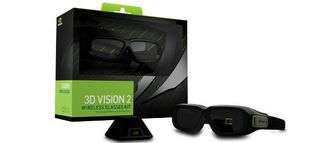NVIDIA improves depth perception with 3D Vision 2

Just when you thought it was safe to put your regular sunglasses back on, NVIDIA releases a sequel to its stereoscopic rendering technology 3D Vision. It's called 3D Vision 2, and funnily enough doesn't have much to do with graphics cards.
The current crop of 3D Vision cards and drivers are already more than competent at adding a second camera angle to games, and work with pretty much any DirectX game. For 3D Vision 2, then, NVIDIA have focussed on the supporting hardware.
For starters, there's a new set of active shutter glasses, with larger lenses for larger screens and a new, apparently more comfortable, frame. The new lenses are also better at blocking out light, which should make it less likely that you see left eye pictures in your right eye and vice versa.
Perhaps more interesting is a new feature for monitors called 3D LightBoost. This ups the brightness and contrast levels, in order to overcome the fact then when you look through the dark lenses of a pair of 3D glasses, everything goes, well, a bit dark. The new spec also covers better antighosting.
I've unknowingly tested one of these screens in the last week, on the Toshiba X770 laptop which was sent in for a group test appearing next month. While I'm still not personally sold on 3D, it is probably the best laptop screen I've ever used for 2D – especially on a 17inch machine.
Other screens which will support 3D Vision 2 and 3D LightBoost include the 27inch ASUS VG278H.

Is 3D there yet? NVIDIA's general manager of 3D Vision, Phil Eisner, reckons that people who have the hardware use it stereoscopically about 50% of the time, and that there are 60 plus screens and laptops which support 3D Vision on sale.
PC Gamer Newsletter
Sign up to get the best content of the week, and great gaming deals, as picked by the editors.
My concern is that the new 3D Vision 2 spec doesn't cover graphics hardware – and Eisner says there are no plans to in the future either. In his place, I'd consider that just as important as getting the screens right.
The reason is that there's a trend with gaming laptops at the moment for manufacturers to kit out machines with expensive screens and glasses, and then use a second tier GPUs to keep the price down. Like putting a GeForce GTX 560M in a £1,500-ish laptop, when AMD's Mobility Radeon HD6990 is available in competitors for the same price. In my experience so far, the GTX 560M is not a chip which can produce playable framerates consistently in native resolutions with 3D on. The worry would be that if anyone is buying a laptop specifically for 3D gaming (does such a person exist?) they're going to find it hard to get games running smoohtly, and be put off the technology for several more revisions.
At this stage, where the technology is way ahead of consumer demand, it would make more sense to ensure the best possible experience at the expense of getting the 3D Vision logo onto everything. That's my two penn'orth, anyway.
Like it or not, though, 3D is here to stay and with near ubiquitous hardware and software compatibility it's likely just a matter of time before everything is 3D compatible. And if things like 3D LightBoost benefit us all, maybe it's not such a bad thing.
NVIDIA says there are over 550 current PC games compatible with the 3D Vision and 3D Vision 2, by virtue of the fact it works with almost any DirectX software. They're doing all they can to ensure new releases are supported at launch too, so Batman: Arkham Asylum, Assassin's Creed: Revelations and LA Noire will (should) all work with your 3D specs straight away.
